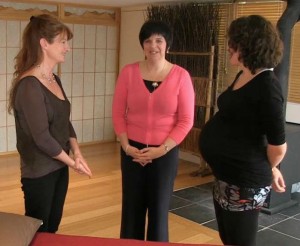To read the previous part, go to Why would someone want to see an osteopath?
Pour lire la partie précédente, voir Qu’est-ce qui pourrait m’amener à prendre rendez-vous avec un ou une ostéopathe?
The post-partum period is a critical stage for new mothers, both for recovery after childbirth and welcoming her new baby. The adaptation required by the body during the weeks following birth is intense hormonally, physically, physiologically, emotionally, etc.
Osteopathy, which is a soft approach, can help several symptoms affecting women:
- Post-delivery physical pain: pelvis, pubic symphysis, back, neck; Headaches, tension between the shoulder blades, nerve pain, etc.
- Work the pelvis or pelvic floor;
- Posture balancing;
- Prevention of specific problems associated with stress caused by the baby’s arrival, sleep or breastfeeding problems, digestive issues, perineal pain (tear, episiotomy);
- Fragile emotional state;
- Etc.
The health and wellbeing of the young mother are central to the proper functioning of the family. It’s essential that, after the big moment, she takes care of herself using different methods, including osteopathy. This soft approach allows her to rediscover her balance, get questions to her answers and take the necessary time for herself.
Osteopathy and Babies
You can watch a video about osteopathy and babies.
Vous pouvez visionner la vidéo sur l’ostéopathie et bébé.
Childbirth is intense both for mother and baby. As the delivery date approaches, both start lacking space. The baby’s position is not always optimal (mother’s pelvic form, repositioning of the organs around the uterus, baby mobility associated with the umbilical cord, etc.). Then the shift from intrauterine to extrauterine life requires a lot of physical adaptations! After this kind of adventure, the baby will have many discomforts, and an appointment with an osteopath would be very beneficial for the baby.
When examining a baby after birth, many things need to be considered: pregnancy history (complications, difficulties, monitoring), induction (medically provoked childbirth), amount of time and type of labour, baby presentation, complications, use of vacuum assistance or forceps. In short, a full history of their birth. Your osteopath will ask you all these questions to understand how to take care of your baby as best as possible.
The right choice is to see an experienced osteopath, such as those that work at Odyssée. Babies can be treated by osteopaths specialising in perinatal care, starting in their first weeks of life. When childbirth was very long, very fast or complicated, when breastfeeding is difficult, or they have other problems, osteopaths working at this centre suggest bringing in your baby quickly (some have been treated a few hours after childbirth!). During the first appointment, the baby is treated softly and respectfully, and parents will receive extensive advice on how to adapt to their new life and understand their baby. On the other hand, if everything seems fine, the appointment will be preventative, and the osteopaths at Odyssée will suggest seeing the baby during their first four or five weeks after childbirth.
Osteopaths can help solve many problems experienced by babies during their first weeks of life, such as reflux, bloating, vomiting, crying, stiffness, torticollis, plagiocephaly (flat head), stomach pain and many other symptoms. The emotional field is also considered by the osteopath. This can help the baby release emotional tensions accumulated during the pregnancy and childbirth. The osteopath will use the history (from the start of pregnancy) told by the mother and father to target their work and better help the baby. It is a soft and pain-free procedure for your baby. Of course, that doesn’t mean that they won’t cry during the treatment, or seem uncomfortable from time to time. But their reactions are caused by the technique. After, or even during, the procedures, the baby often peacefully falls asleep.
A classical osteopathy appointment starts with a questionnaire dealing with the pregnancy and childbirth history and the baby’s health since birth, as well as the reason for the appointment. The baby is then examined and treated from head to foot (pelvic mobility, visceral exam for the digestive system, verification of the spinal cord, diaphragm, neck mobility and muscle tension in the case of torticollis, cranial and suture evaluation to prevent, among other things, plagiocephaly, assessment of jaw mobility to help breastfeeding…), which is always adapted to the baby’s situation and needs.
I hope this information about the benefits of osteopathy from preconception to the postnatal period has answered your questions that you may have about this method that is mild and risk-free for both mother and baby.
Talk soon,
Marie
The Baby Expert
Please share your experiences in the comment section.
 Marie Panier DO, obstetric and pediatric osteopath
Marie Panier DO, obstetric and pediatric osteopath
Marie-Hélène Fortier-Roy DO, obstetric and pediatric osteopath
L’Odyssée, d’une naissance à une autre
819 842-4545
29, chemin Beaudette
Canton de Hatley QC JOB 2C0


